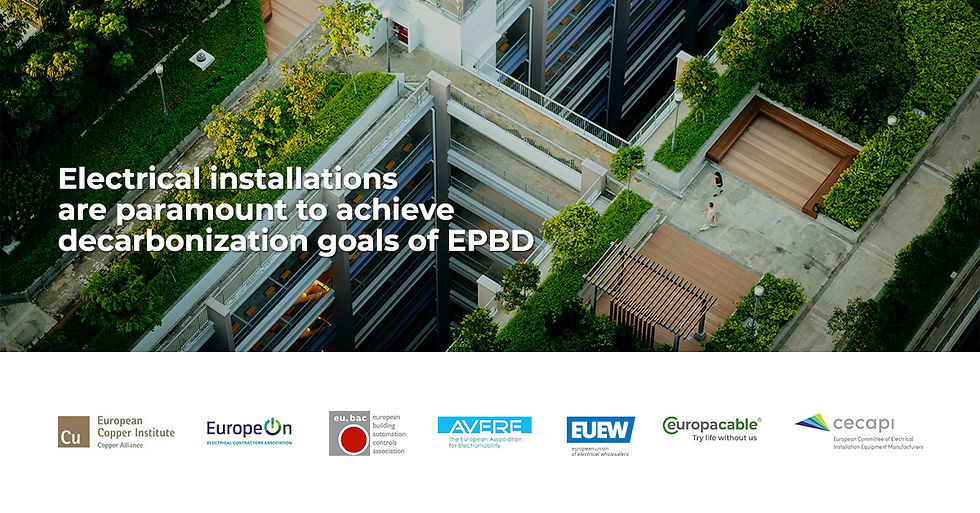Joint letter on support of electrical installations
- EUEW

- May 31, 2023
- 3 min read
Reaction to the amendments adopted by the European Parliament on the recast of the Energy Performance of Buildings Directive (EPBD).

The decarbonization of buildings via electrification is contingent on the capacity of electrical installations in buildings. Up-to date and adequately dimensioned electrical installations are a pre-requisite to integrate the required energy performant devices, such as heat pumps, solar PV, battery storage, EV recharging points, electrically operated solar shading and Building Automation and Control Systems (BACS).
In practice, when heat pumps, solar PV, EV-recharging points are to be installed in buildings, one of the first questions of professionals (planners, installers) is always about the status of electrical installations.
In short, the aims of the EPBD can only be achieved with due consideration of electrical installations throughout the text.

We call on co-legislators to adopt the amendments proposed by the European Parliament to:
Include a definition of electrical installations (Art. 2, 6c)
6c. "electrical installation" means a system composed of fixed components, including switchboards, electrical cables, earthing systems, sockets, switches and light fittings, which have the purpose of distributing electrical power within a building to all points of use or transmit electricity generated on-site;
Integrate “electrical installations” into the definition of Technical Building Systems (Art 2.6)
6. "technical building system" means technical equipment for space heating, space cooling, ventilation, domestic hot water, built-in lighting, building automation and control, electrical installations, on-site renewable energy generation and storage, or a combination thereof, including those systems using energy from renewable sources, of a building or building unit;
With over 132 million EU dwellings lacking adequate electrical installations, the EPBD must address this shortcoming head-on, which stands in the way of its aims, could result in significant unforeseen costs if retrofits are needed and pose fire safety risks (disproportionately affecting citizens in energy poverty) if left unattended.
The inclusion of electrical installations in the definition of Technical Building Systems (TBS) is the turnkey policy solution to ensure the smooth attainment of EPBD aims, while minimizing hassle for consumers. Benefits for citizens and businesses stemming from this solution are obvious, and include availability of information in renovation passports, requirements on optimization when retrofitted or replaced, assessment of efficiency and seamless integration of solar energy as well as other renewables. It goes hand in hand with following considerations introduced by the Parliament:
The replacement of obsolete and inefficient TBS, where technically and economically feasible, is part of the steps set out in a renovation passport, in accordance with the energy efficiency first principle (Art. 11, 1.).
Wider benefits related to electrical safety are indicated in renovation passports (Art. 10, 3(cc)).
The requirements set for TBS to reach at least the latest cost-optimal levels and to take into account the relevant economic and environmental optimization standards for the dimensioning (Art. 11, 1).
Optimization of the energy performance of the system when TBS are retrofitted or replaced (Art 8, 2a).
Integration of the efficiency of electrical installations (IEC EN 60364-8-1) into calculation methodology (ANNEX I, point 4, (ib)).
Ensuring regulatory frameworks provide the necessary administrative, technical and financial capacities and incentives for the deployment of solar energy in buildings, including in combination with TBS (Art. 9a, 7), and securing fire safety of solar energy installations in buildings, including in combination with TBS (Art. 9a, 9).
Assessment of the energy efficiency of electrical installations of non-residential buildings is made as part of existing safety inspections schemes, with due regard to the available standard for their optimal design, dimensioning, management and monitoring (Art 20, 4).
Inspection (HVAC > 70kW) to assess the readiness of TBS to work with renewable energy sources (Art 20, 4).



Comments